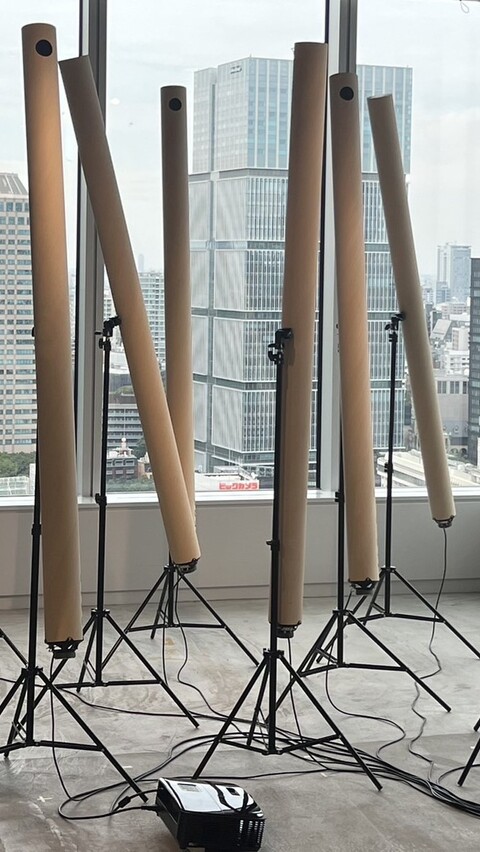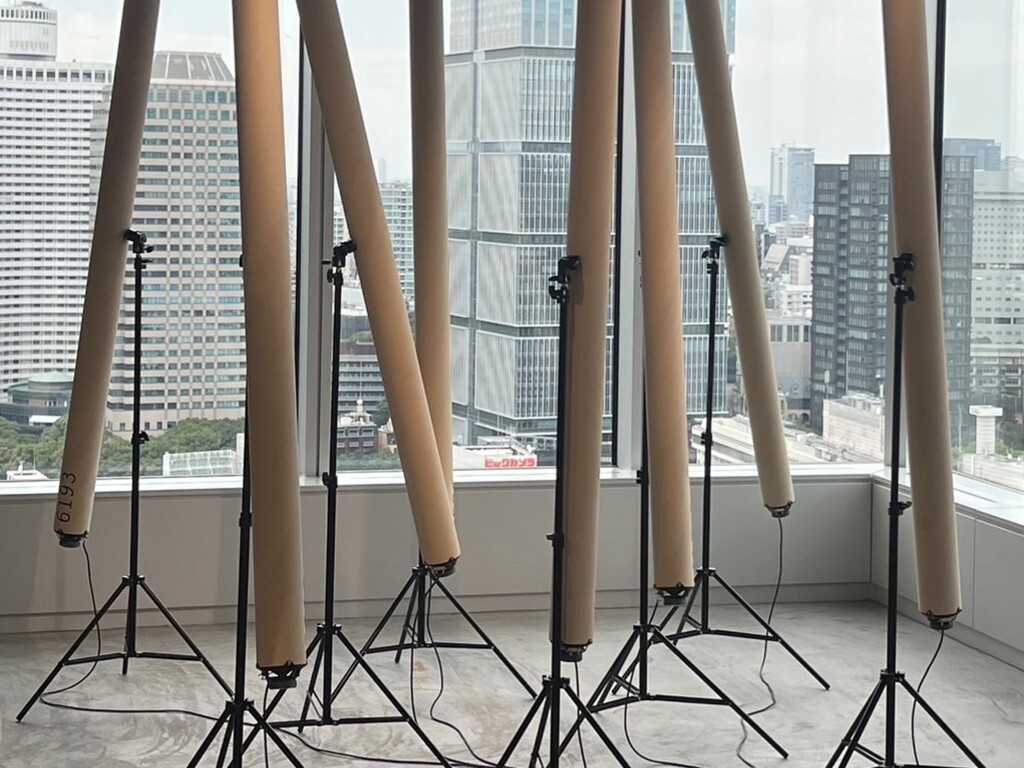During their time in Japan, the Extended Environmental Record / artists and researchers Marcus Maeder and Veronica Mockler blended sonic data, art and collective listening to hear out the intricacies of ecosystems.
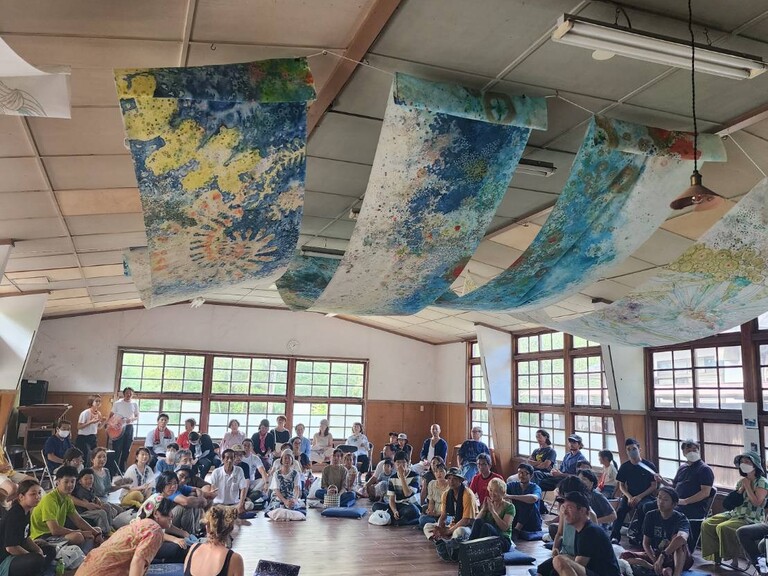
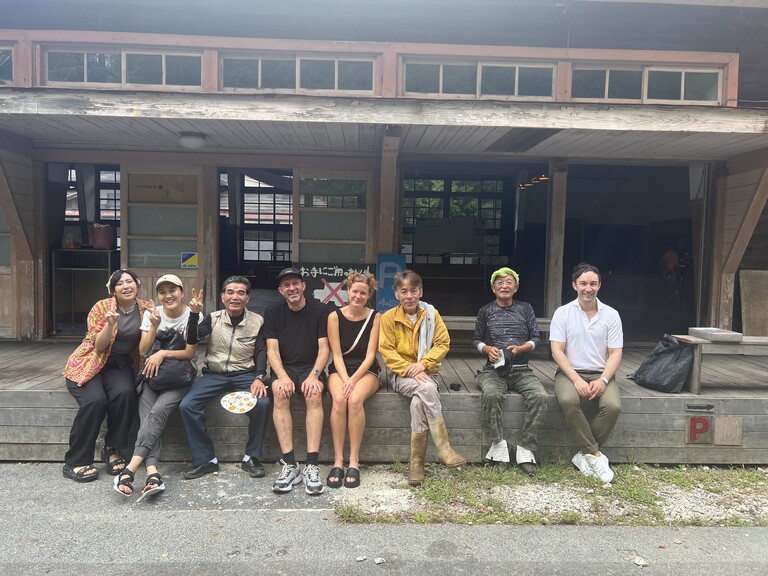
How can the complexity of a forest community be heard by the human ear? Can the physiological processes of trees be translated in a language that is understandable to humans? If we work towards understanding what the trees are telling us, what will we say in return? The Extended Environmental Record — consisting of Shimoichi-cho residents as well as artists and researchers Marcus Maeder (Switzerland) and Veronica Mockler (Canada) — stayed in Japan in the autumn of 2023 to engage with these questions, using a mix of sensors placed in nature as well as a dialogical inclusion to create a collective performance at the invitation of Mind Trail festival in Nara, Tokyo Biennale, and the Vitality.Swiss program.
As part of the Extended Environmental Record EER collective, the artists installed a TreeNet measuring station for a one-year duration in the Nara forests and began to collect the initial growth and health data of three trees. The purpose of TreeNet, a network of IoT sensors operated in partnership by the Swiss Federal Institute for Forest, Snow and Landscape Research WSL, ETH Zurich and the University of Basel, is to generate data sets on tree growth and tree water dynamics for research, and to provide near real-time indicators of forest growth performance and its handling of drought stress to a broad audience.
While conducting eco-physiological measurements to assess how the forest copes with drought in the face of climate change in Nara, the EER Collective also focused on spoken experiences from residents, farmers, and forestry workers through a series of dialogue sessions in the forest. The residency culminatd in a sound performance, blending data sonification, oral history sampling, analog synthesis, and acoustic field recording. This performance was presented twice: as part of the Mind Trail Festival with the Shimoichi-cho community on September 17th, and during the opening ceremony of Tokyo Biennial’s Art Farm on September 23rd.
In addition, Marcus Maeder presented his installation “Growth Model”, a collaboration with Roman Zweifel, in the context of Tokyo Biennale. Making use of TreeNet measurements collected in Switzerland, the installation “Growth Model“ sonifies data of the growth period 2018 (March-October) of 8 selected trees, and brings these data into a sonic-artistic form of experience.
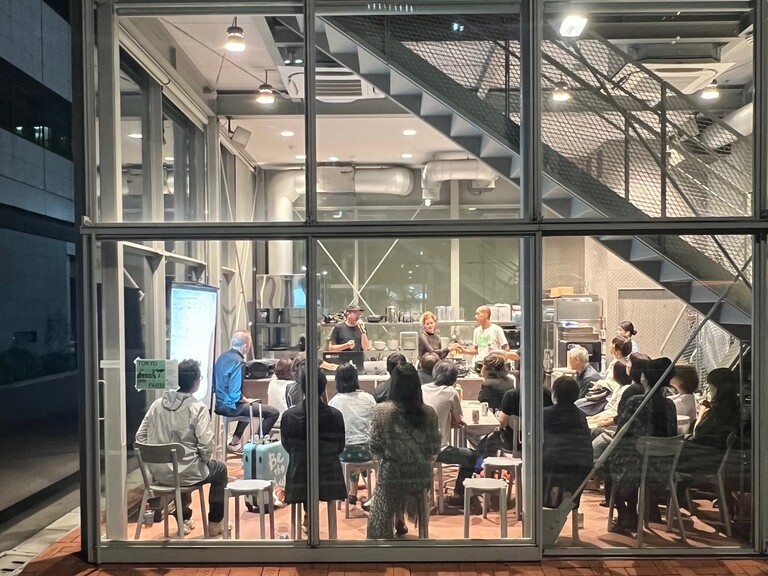
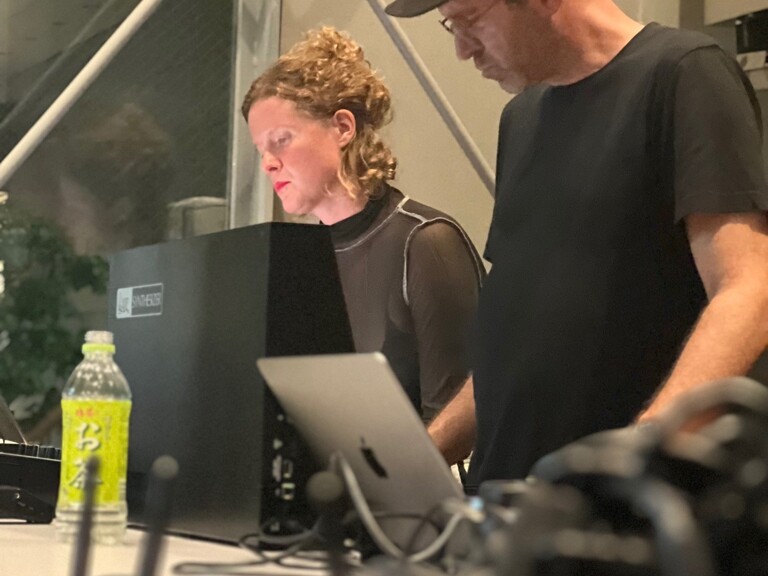
More on the Extended Environmental Record
The Extended Environmental Record is a recurring and collective listening practice. It understands the environment as including the nonhuman and human, alongside their relationships and intersections. EER upholds and develops difference within working, artistic, and scientific forms of knowledge and decenters them from market and institutional authority. The Record shares its content based on the situated needs and dialogical decision-making of its members.
For its work in Japan, the Extended Environmental Record is collaborating with MIND TRAIL OKUYAMATO Museum In Your Mind and the 2023 Tokyo Bienniale, in partnership with Vitality.Swiss.
FEATURING Taisuke Eida (Forester, Japan), Takashi Noguchi (Forester, Japan), Toshihiko Mukai (Farmer, Japan), Kaori Takano (Local resident, Japan), Makiko Mori (Local resident, Japan), Yoshifumi Mizuguchi (Local resident, Japan), Yuri Nishiyama (Creative team, MIND TRAIL, Japan), with Veronica Mockler (Artist, researcher, Canada), and Marcus Maeder (Artist, researcher, Switzerland).
EER Official Partners:
Marcus Maeder: artistic research via the Embassy of Switzerland in Japan, the Pro Helvetia Swiss Arts Council, the Sakae Stünzi Foundation, the Swiss Federal Institute for Forest, Landscape and Snow Research WSL, Institute for Computer Music and Sound Technology ICST, Zurich University of the Arts ZHdK.
Veronica Mockler: artistic research on inclusion amid ecological crisis polarization via the UNESCO Chair on the Prevention of Radicalization and Violent Extremism, Centre for the Study of Learning and Performance, Concordia University, Canada.
Seiichi Saito: Research support and producer of MIND TRAIL, Japan.
Masaki Matsubara: Local collaborator, Japan.
Vivek Venkatesh: UNESCO-PREV co-Chair, Concordia University.
TreeNet measuring devices: Decentlab AG; NATKON, Roman Zweifel.
Allsounder recording equipment: Elekon AG.
More on Marcus Maeder’s Growth Model
The TreeNet research and observation network (1) has been continuously collecting data on the health of the Swiss forests since 2011. Over 420 trees at 61 sites are monitored in the automated sensor network. The goal of TreeNet is to generate high temporal resolution datasets on tree growth and tree water dynamics for research and to provide near real-time indicators of forest growth performance and their management of drought stress to a wide audience.
In recently published studies (2,3), the dynamics of tree growth in TreeNet were observed in detail for the first time and astonishing things were discovered: trees grow mainly at night, when they fill their vessels and cells with water from the soil and the turgor pressure in the cells is sufficiently high. Each tree species grows at a different rate and in different time windows during the year - the increasing dryness in the course of climate change also has its influence on the growth of trees in Switzerland.
In the installation „Growth Model“ the data of the growth period 2018 (March-October) of 8 selected trees are sonified, i.e. brought into a sonic-artistic form of experience. In the process of sonification, series of measurements are used to drive sound generation on a computer.
The ash tree (Fraxinus excelsior) is an important tree species for the forest and timber industry. It is a deciduous tree and its wood is used wherever strength and elasticity are required; for example, in tool handles and stalks or sports equipment. It is not only climate change with longer and more intensive dry and hot periods that causes problems, but in recent years also the ash shoot dieback, which is caused by an introduced fungus. In addition, the tree species is attacked by the Asian ash borer beetle and it is to be feared that the ash tree in Europe will be very severely decimated in the coming decades.
The Growth Model installation consists of ash wood tubes, each of which has a speaker chassis embedded in it. The hollow body of the tubes is stimulated to vibrate by the loudspeakers - the objects thus become electro-acoustic instruments on which the growth data of ash trees at three locations in the TreeNet (Lägern ZH, Schänis SG and Visp VS) are played as sounds. In the exhibition space, the date and time of the measurement data played back in the installation is projected in order to be able to relate the sonifications/ growth spurts to the time of day and season.
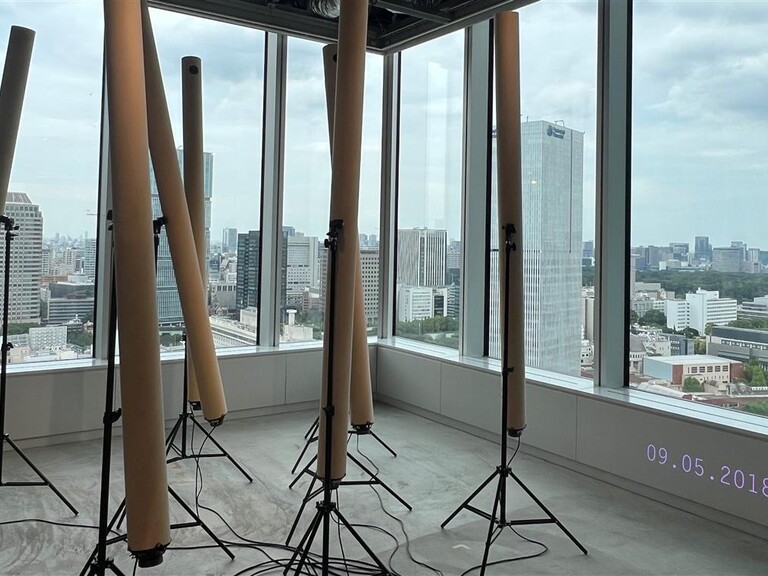
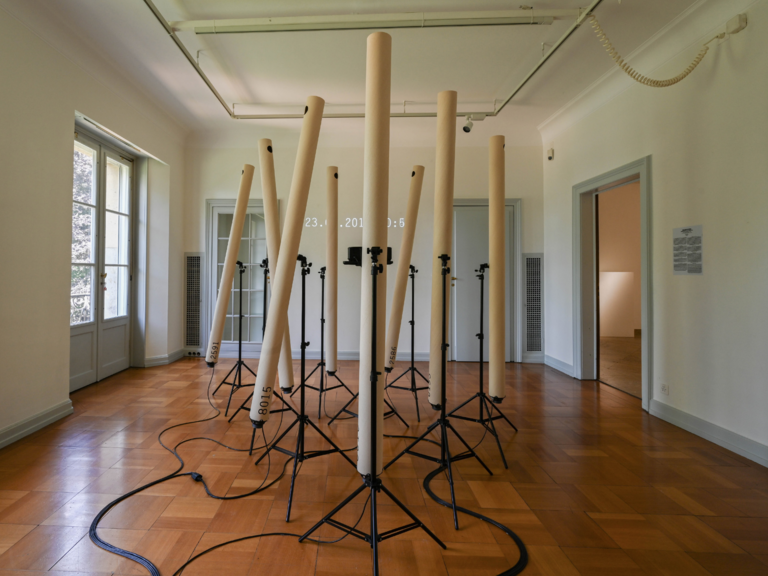
Artistic concept and realization: Marcus Maeder Measurements and data preparation: Roman Zweifel
Programming: Ken Gubler
1. Zweifel R, Etzold S, Basler D, Bischoff R, Braun S, Buchmann N, Conedera M, Fonti P, Gessler A, Haeni M, Hoch G, Kahmen A, Köchli R, Maeder M, Nievergelt D, Peter M, Peters RL, Schaub M, Trotsiuk V, Walthert L, Wilhelm M and Eugster W (2021) TreeNet–The Biological Drought and Growth Indicator Network. Front. For. Glob. Change 4:776905. doi: 10.3389/ ffgc.2021.776905
2. Zweifel R, Sterck F, Braun S, Buchmann
N, Eugster W, Gessler A, Häni M, Peters RL, Walthert L, Wilhelm M, Ziemińska K. Why trees grow at night. New Phytologist. 2021 Jun 12.
3. Etzold, S., Sterck, F., Bose, A.K., Braun, S., Buchmann, N., Eugster, W., et al. (2021) Number of growth days and not length of the growth pe- riod determines radial stem growth of temperate trees. Ecology Letters, 00, 1– 13. Available from: https://doi.org/10.1111/ele.13933
www.treenet.info
exhibitions: Touch Wood, ZAZ Museum Bellerive, Zurich, Switzerland (June-Dec 2022)
Marcus Maeder
Marcus Maeder is a Swiss artist, researcher and composer of electronic music. As an author, Maeder has written on a number of topics in the fields of sound art, acoustic ecology, artistic research and digital media.
Maeder studied Fine Arts at the Lucerne University of Applied Sciences, Philosophy at the Fernuniversität in Hagen and currently pursues his PhD in Environmental Systems Science at ETH Zürich. He runs the music label domizil together with Tobias Gerber, Ken Gubler, Claudio Landolt, Mélia Roger and Vivian Wang. Maeder has worked as an editor and producer for the Swiss radio station SRF and has been working as a researcher at the Institute for Computer Music and Sound Technology (ICST) of the Zurich University of the Arts ZHdK since 2005.
In his research, Maeder is working on ecoacoustic investigations of areas, communities and organisms under the influence of climate change and other environmental issues. He contextualises his artistic and scientific work in the fields of Acoustic and Soundscape Ecology, as well as Artistic Research.
Veronica Mockler is an artist and researcher of participatory dialogue that transform the act of listening to others into art form. Politically collaborative, her work takes on various shapes, including private interviews, public addresses, media performances, and listening scores (Digital Art Studio, 2016; Belfast IE/UK); (Third Shift, 2018; Saint-John CA); (Maison des Artistes, 2019; Winnipeg CA); (SBC Gallery, 2020; Montreal CA); (UnionDocs, 2022; NYC US); (Dazibao, 2024; Montréal CA). Beyond curated art spaces, her practice has unfolded within a diverse range of settings, spanning from official government events for elected representatives to educational and academic institutions, to community organizations.
Mockler holds a Master of Arts in Fine Arts from Concordia University, where she currently works as an associate artist and researcher as part of Project Someone at the UNESCO Chair in the Prevention of Radicalization and Violent Extremism. The arts-based research she carries out for the chair focuses on the challenge of institutional inclusion and working-class solidarity amid the polarizing effects of our ecological crisis. She has received awards and bursaries for her work, including recognition from the Conseil des arts de Montréal (2022) the Canada Council for the Arts (2022), the Conseil des arts et des lettres du Québec (2019), and the Fonds de recherche du Québec (2021), as well as the First Prize by the Mécènes investi-es pour les arts for her citizen-centered performative investigation on the right to housing in Montreal, titled The Address (2019). Nodding to the traditions of oral history, documentary-making, and radical working-class education, her work redefines who gets to be heard within the institutions of art, citizenship, and knowledge.
